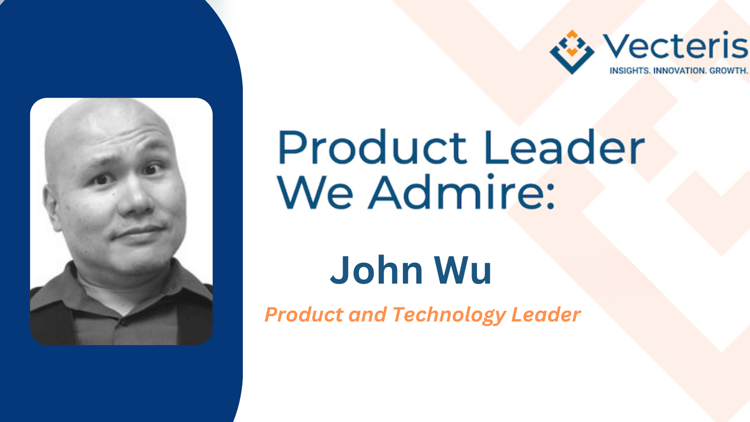Product Leader We Admire: John Wu

We frequently like to profile Product Leaders we admire to help inspire you and your team. This month, we are excited to introduce you to John Wu.
Favorite Product Book:
Depending on the PM role, I’d like to recommend a few:
For brand new product managers, I would recommend Dan Olsen’s “Lean Product Playbook” and “Business Model Generation” by Alexander Osterwalder; I understand this book is used in some business schools. Dan Olsen’s book will help product managers with their day-to-day activities, while Osterwalder’s provides a good foundation for creating a product strategy.
For product leaders and this will sound unconventional, though I would recommend “Little Bets” by Peter Sims and “Thinking in Bets” by Annie Duke. Sims’ “Little Bets” focuses on how to create a process for continuous innovation, and Duke’s “Thinking in Bets” deals with your decision-making process because, let’s face it, the product team’s main job is to make decisions.
Lastly, for experienced product managers who’ve got the basics down, I would recommend “Hooked” by Nir Eyal on building sticky products that customers want.
Tips or Advice for a New Product Manager:
Regardless of the product or market type, ensure you understand and communicate the “Why”.
- Why did the customer ask for X features?
- Why did users use or stop using X?
- Why is X important to the buying decision-maker?
Keep asking why until you understand the foundational motivation behind what your buyers and users say or do. Knowing the Why will improve your ideation, design, and prioritization decisions. But don’t stop there; make sure you understand, document, and share the Why with the rest of the team, whether they be designers, writers, engineers, testers, marketers, sales and customer support, or customer success. Knowing Why behind your decisions and requirements will empower them to use their expertise to make the product better and make you more effective
Tips or Advice for a Product Leader:
Focus on your product management process. My personal experience shows that the biggest cause of poor execution, missed requirements, schedule or cost overruns, and so on, are caused by poorly designed or poorly implemented processes. By not knowing who does what, who’s responsible for what, who’s authorized to make what decisions, and how each team member interacts with each other, a team loses A LOT of time due to inefficiencies and confusion. Also, if there is poor alignment between responsibility, accountability, and authority, the team will spend more time fighting the process instead of the market problem you need them to solve. Vision, Ideas, and Innovations are great, but none of that matters if the team fails to execute.
I have a simple framework that helps to define each person’s roles within your product management process. If you know the Purpose, Authorities, Responsibilities, and Tasks of each role within your product development and management process, you will know how each person plays their “PART” in the process. This will also ensure there is a clear alignment between Purpose, Authority, and Responsibility, thus Accountability as well. The acronym I use is PART… and yes that is intended as a pun.
The Biggest Product Failure and Lessons Learned:
I think the biggest failure or lesson learned is my most recent effort. The failure is less of a failed product than a failure in how I approached the problem. Early on in my most recent work, I crafted a product vision and a process to validate the vision and roadmap, along with a 3-year technology roadmap that will enhance our ability to innovate across the entire product portfolio. However, I failed to consider the internal company structure and inherent conflicts of interest. I did not take the time to gain proper alignment across all the executive stakeholders, resulting in a significant delay in the effort. The whole effort is less successful than it could have been.
So, the biggest lesson learned here is that it’s important to constantly “manage up” and treat your internal stakeholders like customers - understand their underlying needs and concerns, so you can address them properly and get (and keep) that alignment throughout the entire product lifecycle.
The Product Team's Failure and Lessons Learned:
In terms of product team failure and lessons learned, this ties back to the process tip that I had. I had the luck (or misfortune) of building a product team from scratch multiple times. During one of those times, I was able to hire both experienced product managers and bring in subject matter experts who wanted to move into product management, where previously I hired junior or brand new product managers. It was a few months into the process before I realized that the program that I used to onboard and train the new product managers was very different than how the experienced product manager was working with their SCRUM and design team. Because of the differences in process, I created unintended confusion and friction in how the work is done. It took me a couple of months to smooth out the bumps and even longer to regain credibility with my internal partners, which created unnecessary delays and cost overruns. Since then, I’ve been very focused on the onboarding process because I have learned that if this is effective and resilient, everything else will take care of itself.
If you know a Product Leader in your organization who deserves recognition, please don't hesitate to let us know! We are always looking to feature inspiring individuals in the industry.
